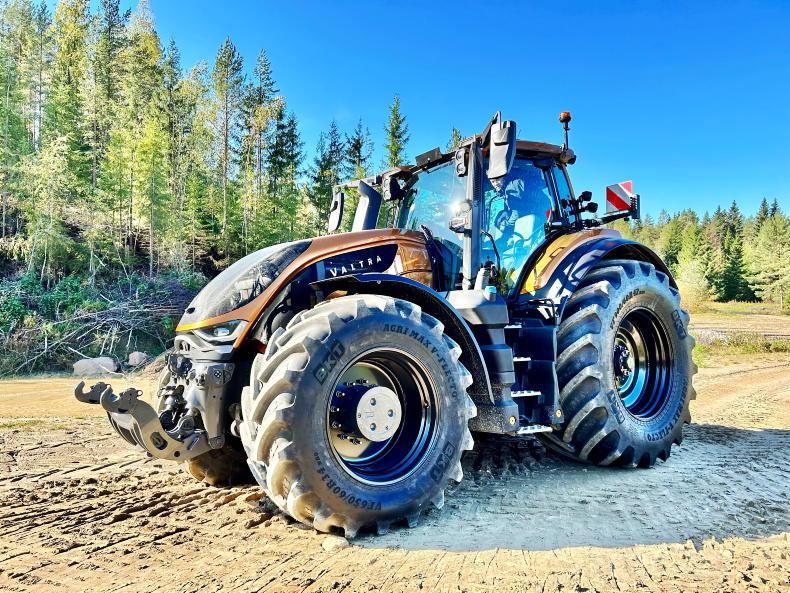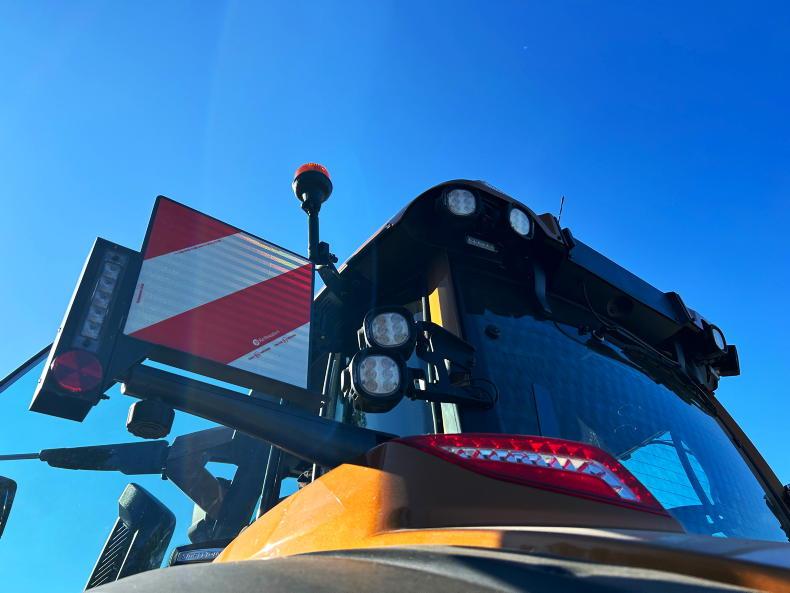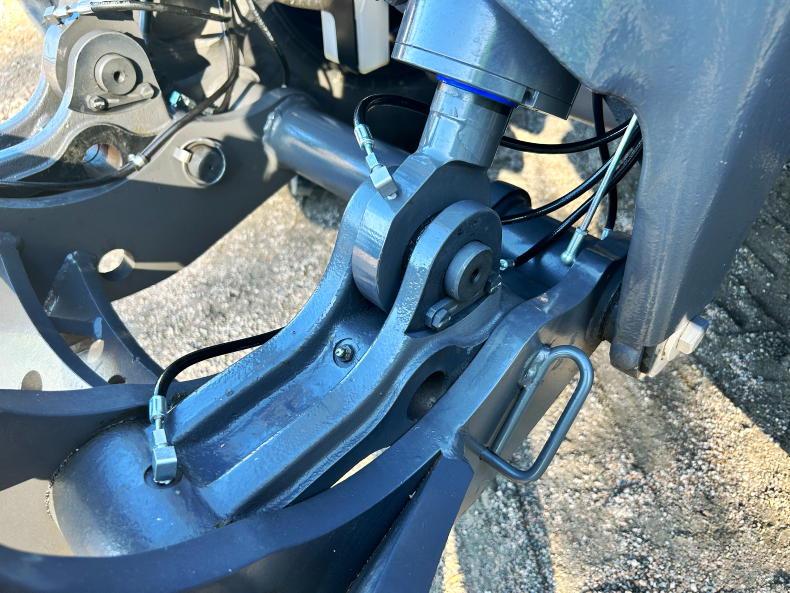Valtra has unveiled a fully revamped S Series flagship tractor range. The six-model line-up from 280hp to 420hp returns to its Finnish beginnings, where it will be built in Suolahti, alongside the A, G, N, T and Q Series.
The flagship range escalates from being essentially an outlier, having little in common with the rest of the line up, to now fitting into the Valtra architecture, and at the same time pioneering the sixth generation lifecycle.

The S416 not only leads the pack with 420hp, but is the most powerful tractor built by Valtra.
Made in Finland
Key to the brand’s identity and heritage, production of the S6 now returns home to Suolahti, Finland, after 22 years. To Valtra, the unveiling of the S6 was equally as much as a homecoming celebration as it was a launch of a global tractor series. While many may not recall, the first generation S Series was built from 1999 to 2001 in Suolahti, before AGCO acquired the Nordic tractor manufacturer. With the acquisition, structures changed, resulting in the later S2, S3 and outgoing S4 generations being heavily based on the Massey Ferguson 8700S platform and built in its Beauvais plant in France.
The move back to Soulahti has been a long time coming and the result of significant investments within the Nordic tractor plant to both increase capacity and accommodate the larger S Series chassis. Such investments include a new, fully robotic paint shop that not only claims a better finish, but reductions in tack time and the possibility of further future expansion.
The new paint shop at Suolahti allows for increased throughput.
With the new paint shop solving production bottle necks, senior management outlined that the transmission machining and assembly area was next in line for improvement. The facility is currently undergoing expansion in order to accommodate the assembly of the shared AGCO ML 260 CVT transmission for its S and Q Series. Until now, sister company, Fendt solely built these units in Marktoberdorf, Germany. Initially built for its own 900 Vario models and more recently for its sister companies and third party customers, therefore, increasing demand.

A first generation S260, alongside the new S416.
Engine and transmission
The new ‘Boss’ Series, as its being titled by Valtra, is the firm’s most powerful tractor range to date, ranging from 280-420hp, through six models. Common to all models is the LX84TN, 8.4l six-cylinder AGCO Power engine. This latest variant sheds its twin-turbo setup to one single turbo now. Also, due to an improved emission-after-treatment system, there is no longer need for an EGR (exhaust gas recirculation), leaving the engine now operating at a slightly lower temperature, reducing the overall cooling requirements.
However, AdBlue usage has fractionally increased with a greater reliance also placed on the DOC, DPF, SCR, and essentially the rest of the exhaust-after-treatment system. Ironically, the S1 first built in 1999 was the first tractor series to pass down the Suolahti production line fitted with an EGR.
The S286, 420hp (see Table 1) and S376 have a 30hp power boost, while the S396 has a 20hp boost. The flagship S416 churns out a constant 420hp.
Overall, the sixth gen tractors boast a 5% power output increase, 9% torque increase and a 3% decrease in fuel consumption, compared with the outgoing range. Coupled to the revised power unit is the proven AGCO ML 260, CVT. This two-range (range one 0-28km/h) box has a top speed of 53km/h. Although the same unit as that is found in the Q Series, the input shaft, damper, half axles, and the PTO have all been reinforced to withstand the additional power and torque of the Boss.

The proven ML 260 transmission for the Q and S will be assembled in Suolahti going forward.
Capacities and hydraulics
Front- and rear-lift capacities go unchanged from before at 12,500kg on the rear linkage and 5,400kg on the front linkage. UK and Irish models remain fitted with the Irish built, Dromone pickup hitch. Operators can choose from 540E, 1,000 or 1,000E PTO speeds. The weight distribution of the S Series is split 48/54 percentage to the front and rear axles.
The base weight can be increased by up to 2,300kg on the front and 1,500kg on each rear wheel, taking its maximum gross permissible weight to 16,000kg at 50km/h.
The hydraulic system has been the subject of a major overhaul. Base models feature a 200l/min load-sensing piston pump and up to six spools and a power beyond connection.
An Eco function provides the full 200l/min at just 1,650rpm by engaging a second 80l/min gear pump. Otherwise, the maximum flow is achieved using the primary pump at 1,950rpm.
Standard spool flow rate is 120l/min, while 140l/min valves are optional. A second 200l/min load-sensing pump can be fitted, taking the total capacity to 400l/min. This configuration is only available with six spools, five of which have outputs of 140l/min and one of 170l/min, for the most demanding of tasks.

If a second 200l/min load-sensing hydraulic pump is added, hydraulic capacity is doubled to 400l/min.

The S6 has improved storage, with a spacious locker moulded into the fuel tanks.
Cab and controls
The S6 adopts the all-familiar cab of the Q and T Series, which is arguably a big improvement on the previous MF cab. Some changes have been made to the cabin for the S6, access has been improved and an increased number of LED work lights have been fitted. The launch model was equipped with dual colour, fully configurable LED work lights. Not only can the colour be changed from a cool white to warm yellow incandescent tone, but every light can be turned on/off individually, depending on user preference. 
An increased number of work lights have been fitted to the S Series.
Another major selling point for Valtra, having S Series production back home in Soulahti, is that the Unlimited Studio can be availed of.
The Unlimited View roof, Twin Trac reverse drive system, Unlimited View camera system, and central lubrication system, are just a flavour of what can be fitted through the facility. Senior management staff outlined that the uptake rate of the Unlimited Studio increases proportionally in accordance to tractor series. 
Through the Unlimited Studio any additonal extra's or accessories can be fitted such as a central lubrication system.
So far, 80% of Irish and UK Q Series tractors are fitted with add-ons from the Unlimited Studio, which is expected to be the same or more with the S6.

The S Series now adopts the familiar Q and T Series cab.
From the onset, the new S6 really fits into the brand’s current tractor portfolio, maybe too much so, given that it marks the start of the sixth generation lifecycle. Either way, it has gone from being the long-in-the-tooth, older sibling, which went largely unchanged since 2014, to now fitting into the family and paving the way forward.
Having driven the S416, it feels exceptionally compact for a tractor pushing out 420hp. Whether it’s down to the front-sloping bonnet or not, we’d consider it a major win. Inside the cab, the environment is identical to the T5 and Q5 ranges and is top class. Given the large stature of the S6, we wondered did it warrant a slightly larger, more spacious cab, or an updated SmartTouch Armrest?

The front-sloping bonnet leaves the S6 feeling compact and nimble.
Nevertheless, on first impressions, the S6 is a cracking tractor with a proven recipe for success underneath. A tried-and-tested engine, a smooth and established transmission, and an existing, well laid out and comfortable cab, coupled with the ability to be fully customised in the Unlimited Studio – meaning the new S Series has the potential to be a real competitor within its power band.
While there were no new S4 tractors registered in Ireland and an annual number below 30 in the UK, we believe the S6 will greatly improve on this, now that it’s purely Valtra DNA underneath.
Aside from its first public unveiling at the Agritechnica Show in Germany next month, the new S6 will feature on the Valtra stand at Lamma in January, ahead of production ramping up in April 2024.

The out-going French-built S4 generation was based on the MF 8700S series.
Valtra has unveiled a fully revamped S Series flagship tractor range. The six-model line-up from 280hp to 420hp returns to its Finnish beginnings, where it will be built in Suolahti, alongside the A, G, N, T and Q Series.
The flagship range escalates from being essentially an outlier, having little in common with the rest of the line up, to now fitting into the Valtra architecture, and at the same time pioneering the sixth generation lifecycle.

The S416 not only leads the pack with 420hp, but is the most powerful tractor built by Valtra.
Made in Finland
Key to the brand’s identity and heritage, production of the S6 now returns home to Suolahti, Finland, after 22 years. To Valtra, the unveiling of the S6 was equally as much as a homecoming celebration as it was a launch of a global tractor series. While many may not recall, the first generation S Series was built from 1999 to 2001 in Suolahti, before AGCO acquired the Nordic tractor manufacturer. With the acquisition, structures changed, resulting in the later S2, S3 and outgoing S4 generations being heavily based on the Massey Ferguson 8700S platform and built in its Beauvais plant in France.
The move back to Soulahti has been a long time coming and the result of significant investments within the Nordic tractor plant to both increase capacity and accommodate the larger S Series chassis. Such investments include a new, fully robotic paint shop that not only claims a better finish, but reductions in tack time and the possibility of further future expansion.
The new paint shop at Suolahti allows for increased throughput.
With the new paint shop solving production bottle necks, senior management outlined that the transmission machining and assembly area was next in line for improvement. The facility is currently undergoing expansion in order to accommodate the assembly of the shared AGCO ML 260 CVT transmission for its S and Q Series. Until now, sister company, Fendt solely built these units in Marktoberdorf, Germany. Initially built for its own 900 Vario models and more recently for its sister companies and third party customers, therefore, increasing demand.

A first generation S260, alongside the new S416.
Engine and transmission
The new ‘Boss’ Series, as its being titled by Valtra, is the firm’s most powerful tractor range to date, ranging from 280-420hp, through six models. Common to all models is the LX84TN, 8.4l six-cylinder AGCO Power engine. This latest variant sheds its twin-turbo setup to one single turbo now. Also, due to an improved emission-after-treatment system, there is no longer need for an EGR (exhaust gas recirculation), leaving the engine now operating at a slightly lower temperature, reducing the overall cooling requirements.
However, AdBlue usage has fractionally increased with a greater reliance also placed on the DOC, DPF, SCR, and essentially the rest of the exhaust-after-treatment system. Ironically, the S1 first built in 1999 was the first tractor series to pass down the Suolahti production line fitted with an EGR.
The S286, 420hp (see Table 1) and S376 have a 30hp power boost, while the S396 has a 20hp boost. The flagship S416 churns out a constant 420hp.
Overall, the sixth gen tractors boast a 5% power output increase, 9% torque increase and a 3% decrease in fuel consumption, compared with the outgoing range. Coupled to the revised power unit is the proven AGCO ML 260, CVT. This two-range (range one 0-28km/h) box has a top speed of 53km/h. Although the same unit as that is found in the Q Series, the input shaft, damper, half axles, and the PTO have all been reinforced to withstand the additional power and torque of the Boss.

The proven ML 260 transmission for the Q and S will be assembled in Suolahti going forward.
Capacities and hydraulics
Front- and rear-lift capacities go unchanged from before at 12,500kg on the rear linkage and 5,400kg on the front linkage. UK and Irish models remain fitted with the Irish built, Dromone pickup hitch. Operators can choose from 540E, 1,000 or 1,000E PTO speeds. The weight distribution of the S Series is split 48/54 percentage to the front and rear axles.
The base weight can be increased by up to 2,300kg on the front and 1,500kg on each rear wheel, taking its maximum gross permissible weight to 16,000kg at 50km/h.
The hydraulic system has been the subject of a major overhaul. Base models feature a 200l/min load-sensing piston pump and up to six spools and a power beyond connection.
An Eco function provides the full 200l/min at just 1,650rpm by engaging a second 80l/min gear pump. Otherwise, the maximum flow is achieved using the primary pump at 1,950rpm.
Standard spool flow rate is 120l/min, while 140l/min valves are optional. A second 200l/min load-sensing pump can be fitted, taking the total capacity to 400l/min. This configuration is only available with six spools, five of which have outputs of 140l/min and one of 170l/min, for the most demanding of tasks.

If a second 200l/min load-sensing hydraulic pump is added, hydraulic capacity is doubled to 400l/min.

The S6 has improved storage, with a spacious locker moulded into the fuel tanks.
Cab and controls
The S6 adopts the all-familiar cab of the Q and T Series, which is arguably a big improvement on the previous MF cab. Some changes have been made to the cabin for the S6, access has been improved and an increased number of LED work lights have been fitted. The launch model was equipped with dual colour, fully configurable LED work lights. Not only can the colour be changed from a cool white to warm yellow incandescent tone, but every light can be turned on/off individually, depending on user preference. 
An increased number of work lights have been fitted to the S Series.
Another major selling point for Valtra, having S Series production back home in Soulahti, is that the Unlimited Studio can be availed of.
The Unlimited View roof, Twin Trac reverse drive system, Unlimited View camera system, and central lubrication system, are just a flavour of what can be fitted through the facility. Senior management staff outlined that the uptake rate of the Unlimited Studio increases proportionally in accordance to tractor series. 
Through the Unlimited Studio any additonal extra's or accessories can be fitted such as a central lubrication system.
So far, 80% of Irish and UK Q Series tractors are fitted with add-ons from the Unlimited Studio, which is expected to be the same or more with the S6.

The S Series now adopts the familiar Q and T Series cab.
From the onset, the new S6 really fits into the brand’s current tractor portfolio, maybe too much so, given that it marks the start of the sixth generation lifecycle. Either way, it has gone from being the long-in-the-tooth, older sibling, which went largely unchanged since 2014, to now fitting into the family and paving the way forward.
Having driven the S416, it feels exceptionally compact for a tractor pushing out 420hp. Whether it’s down to the front-sloping bonnet or not, we’d consider it a major win. Inside the cab, the environment is identical to the T5 and Q5 ranges and is top class. Given the large stature of the S6, we wondered did it warrant a slightly larger, more spacious cab, or an updated SmartTouch Armrest?

The front-sloping bonnet leaves the S6 feeling compact and nimble.
Nevertheless, on first impressions, the S6 is a cracking tractor with a proven recipe for success underneath. A tried-and-tested engine, a smooth and established transmission, and an existing, well laid out and comfortable cab, coupled with the ability to be fully customised in the Unlimited Studio – meaning the new S Series has the potential to be a real competitor within its power band.
While there were no new S4 tractors registered in Ireland and an annual number below 30 in the UK, we believe the S6 will greatly improve on this, now that it’s purely Valtra DNA underneath.
Aside from its first public unveiling at the Agritechnica Show in Germany next month, the new S6 will feature on the Valtra stand at Lamma in January, ahead of production ramping up in April 2024.

The out-going French-built S4 generation was based on the MF 8700S series.

















 This is a subscriber-only article
This is a subscriber-only article














SHARING OPTIONS: